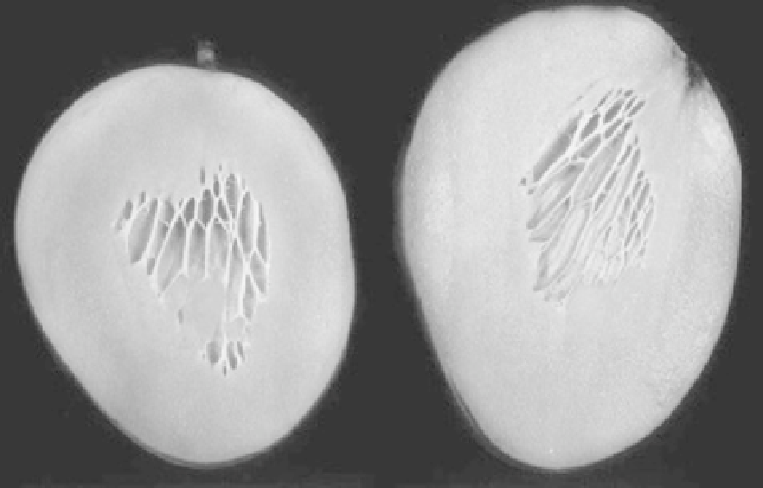Agriculture Reference
In-Depth Information
heated in moist forced air remained cooler than the air. The authors suggest that the latent
heat of condensation may be responsible for the hotter surface temperature during vapor
forced-air heating, and that evaporative cooling may result in the lower surface temperatures
in moist forced air. These data indicate that the water vapor pressure during forced-air
heating influences the surface heat transfer coefficient (Shellie and Mangan, 2000) and has
a tremendous influence on the potential to develop skin scalding.
11.7 Internal damage
Internal injury to fruit can also occur as a result of heat treatment, sometimes in the absence
of any external damage. Internal damage can include flesh darkening in avocado, citrus,
lychee, nectarine, and sapote mammey (Jacobi et al., 1993; Shellie et al., 1993; Lay-Yee
and Rose, 1994; Diaz-Perez et al., 2001; Follett and Sanxter, 2003). Internal damage can
appear in mango and papaya as poor color development, abnormal softening, the lack of
starch breakdown, and the development of internal cavities (An and Paull, 1990; Mitcham
and McDonald, 1993). Jacobi et al. (1996) observed injuries to mango fruit from hot water
treatment, which included surface damage but also internal cavities and starchy layers
beneath the skin (Fig. 11.8). Traditional heat treatments naturally contain a controlled
atmosphere effect because of the modification of internal atmospheres during treatment.
Mitcham and McDonald (1993) demonstrated that CO
2
increased to 13% and O
2
decreased
to 6% in mangoes subjected to high-temperature forced-air treatments and was related to the
development of internal cavitation in the mango fruit. Esquerra and Lizada (1990) showed
a similar modification of the internal atmosphere of “Carabao” mangoes following vapor
heat treatment. Vapor heat-treated mangoes increased in internal cavitation from a range of
Fig. 11.8
Internal injury in mango fruit caused by hot air treatment.









Search WWH ::

Custom Search